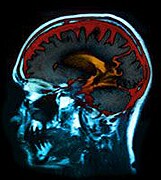
THURSDAY, May 5 (HealthDay News) — Taking birth control pills or hormone replacement therapy could protect women against brain aneurysms later in life, a new study suggests, although one neurologist questioned the quality of the research.
Cerebral aneurysms occur when a blood vessel in the brain weakens and balloons out, potentially leading to a hemorrhagic (or bleeding) stroke if the vessel bursts. These types of aneurysms are more common in women than men, possibly because lower levels of female hormones after menopause play a role in their development, the study authors noted.
Brain aneurysms are more common after the age of 40 and are most likely to burst when people are in their 50s.
In the study, Dr. Michael Chen, of Rush University Medical Center, and colleagues interviewed 60 women who had experienced brain aneurysms and asked about their use of birth control pills and hormone replacement therapy, and compared their answers to those from a group of almost 4,700 other women in the general U.S. public.
The women who had brain aneurysms were significantly less likely to have taken birth control pills or received hormone replacement therapy, and were also more likely to have entered menopause earlier, according to the report published online May 4 in the Journal of NeuroInterventional Surgery.
Previous research has suggested that taking birth control pills lowers the risk of hemorrhagic (bleeding) stroke in later life. However, women who either begin menstruating at an early age, don’t have children, or both, face a higher risk.
Because estrogen is important for the repair and maintenance of blood vessel walls, a drop in the levels of the female hormone is believed to be the reason for the increased risk to the structure of these vessels, the study authors noted in background information about the research.
However, commenting on the study, neurologist Dr. Cathy Sila said the research is flawed and its conclusions overstated.
Other research is more reliable, noted Sila, director of the Stroke & Cerebrovascular Center at University Hospitals Case Medical Center in Cleveland. “Doctors are well-versed in the better data,” she said, adding that she hopes the study doesn’t convince doctors to change how they prescribe birth control and hormone replacement drugs.
Another expert called the finding “interesting,” but stressed that more study was needed.
“[This] deserves additional investigation in a larger group of women,” said Dr. David J. Langer, director of cerebrovascular research at the Cushing Neuroscience Institutes, part of the North Shore-LIJ Health System in Manhasset, N.Y. “Undoubtedly, women maintain higher risk of cerebral aneurysms versus men and the connection to hormonal differences between men and women may be a contributing factor to this preference,” he said.
“Whenever studies like this are published one must be cautious in drawing broad conclusions, but the results do support more research in this area,” Langer added. “One question one could have would be what the incidence of high blood pressure and smoking was in this group of 60 women, and how did that compare with the larger control group?”
In a news release from the journal’s publisher, the study authors stated that they believe their findings add to the understanding of how brain aneurysms develop and progress, and may spur new treatments for patients who either have an aneurysm or are at risk of developing one. Current methods of treatment include blood pressure control, quitting smoking, and possibly a surgical procedure to try to prevent future rupture.
More information
For more about aneurysms, visit the U.S. National Library of Medicine.

